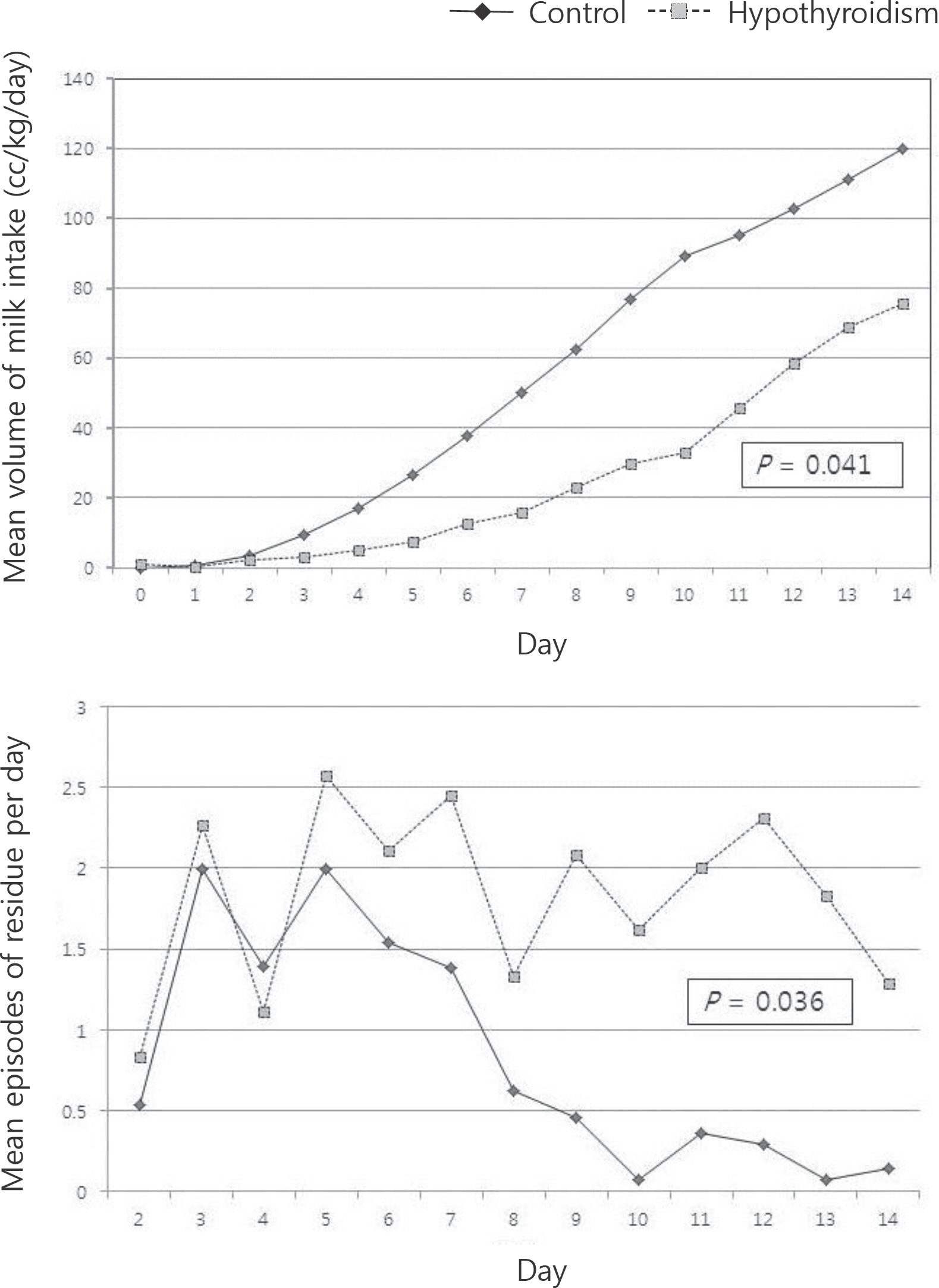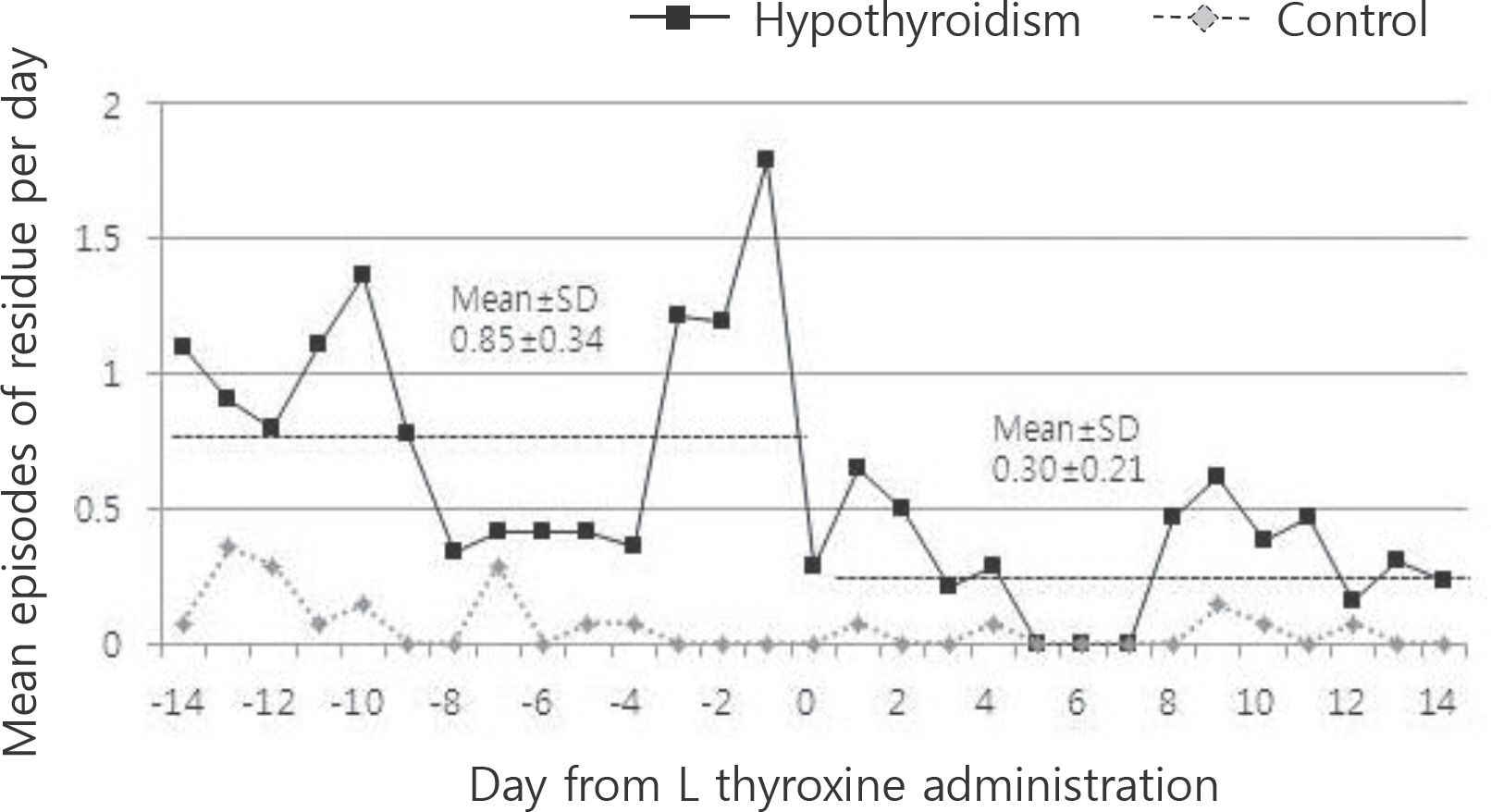Korean J Perinatol.
2015 Mar;26(1):46-52. 10.14734/kjp.2015.26.1.46.
Comparison of Enteral Feeding in Early Neonatal Period in Very Low Birthweight Infants with Hypothyroidism
- Affiliations
-
- 1Department of Pediatrics, College of Medicine, Seoul National University, Seoul, Korea. revival421@gmail.com
- 2Department of Pediatrics, Korea University College of Medicine, Seoul, Korea.
- KMID: 2072336
- DOI: http://doi.org/10.14734/kjp.2015.26.1.46
Abstract
- PURPOSE
We investigated the effects of hypothyroidism on feeding advancement in very low birth weight infants (VLBW).
METHODS
This study was a retrospective case-control study of 14 very low birth weight infants (VLBWIs) diagnosed with hypothyroidism and other 14 infants were recruited as age- and weight-matched controls without hypothyroidism or hypothyroxinemia in Seoul National University Children's Hospital between January 2007 and August 2009. We examined whether these infants gained weight more, achieved full-volume enteral feedings sooner, had fewer episodes of increased pre-gavage residuals, and had fewer days of parenteral nutrition.
RESULTS
Until full enteral feeding (120 mL/kg/day) was not statistically significant between the groups. In the hypothyroidism group, during the first 14 days after birth, the volume of feeding was smaller [14.7 (0.5-84.0) mL/kg/day, P=0.041], the episodes of increased pre-gavage residuals were frequently observed [16.7 (0.2-78) times, P=0.036], and the duration of central line was significantly longer [18 (10-50) days, P=0.018]. In hypothyroidism group, mean day at first L-thyroxine supplementation was 24.2+/-10.2 days after birth. L-thyroxine administration boosted thyroid function for hypothyroidism infants, helped them tolerate a larger amount of enteral feeding [from 89.5 (2.9-160.8) to 146.9 (31.8-178.8) mL/kg/day, P=0.002] and decreased episodes of excessive gastric residuals [from 5.5 (0-41.6) to 0 (0-44) time, P=0.026]. However, no more weight gain was statistically found.
CONCLUSION
In VLBW infants, hypothyroidism may induce feeding intolerance. L-thyroxine supplementation was effective in feeding advancement on preterm infants with hypothyroidism.
MeSH Terms
Figure
Reference
-
References
1. Frank JE, Faix JE, Hermos RJ, Mullaney DM, Rojan DA, Mitchell ML, et al. Thyroid function in very low birth weight infants: effects on neonatal hypothyroidism screening. J Pediatr. 1996; 128:548–54.
Article2. Hong KB, Park JY, Chang YP, Yu J. Thyroid dysfunction in premature infants. Korean J Pediatr. 2009; 52:991–8.
Article3. Kim YC, Seo HJ, Lee KH, Ko CW, Kim HM. Thyroid dysfuction in premature infants. J Korean Soc Neonatol. 2005; 12:165–71.4. Simic N, Asztalos EV, Rovet J. Impact of neonatal thyroid hormone insufficiency and medical morbidity on infant neurodevelopment and attention following preterm birth. Thyroid. 2009; 19:395–401.
Article5. Rastogi MV, LaFranchi SH. Congenital hypothyroidism. Orphanet J Rare Dis. 2010; 5:17.
Article6. Fanaro S. Feeding intolerance in the preterm infant. Early Hum Dev. 2013; 89:Supple 2:. 13–20.
Article7. Jadcherla SR, Kliegman RM. Studies of feeding intolerance in very low birth weight infants: definition and significance. Pediatrics. 2002; 109:516–7.
Article8. Komiyama M, Takahashi N, Yada Y, Koike Y, Honma Y, Aihara T, et al. Hypothyroxinemia and effectiveness of thyroxin supplementation in very low birth weight infants with abdominal distension and poor weight gain. Early Hum Dev. 2009; 85:267–70.
Article9. Battaglia FC, Lubchenco LO. A practical classification of newborn infants by weight and gestational age. J Pediatr. 1967; 71:159–63.
Article10. Charafeddine L, D'Angio CT, Phelps DL. Atypical chronic lung disease patterns in neonates. Pediatrics. 1999; 103:759–65.
Article11. Jobe AH, Bancalari E. Bronchopulmonary dysplasia. Am J Respir Crit Care Med. 2001; 163:1723–9.
Article12. Yaylali O, Kirac S, Yilmaz M, Akin F, Yuksel D, Demirkan N, et al. Dose Hypothyroidism affect gastrointestinal motility? Gastroenterol Res Pract. 2009; 2009:529802.13. Ebert EC. The thyroid and the gut. J Clin Gastroenterol. 2010; 44:402–6.
Article14. Shafer RB, Prentiss RA, Bond JH. Gastrointestinal transit in thyroid disease. Gastroenterology. 1984; 86:852–5.15. Lucas A, Bloom SR, Aynsley-Green A. Postatal surge in plasma gut hormones in term and preterm infants. Biol Neonate. 1982; 41:63–7.16. Valdez MG, Go VLW, Berseth CL. Gestational maturation of regionally distributed gastrointestinal hormones in preterm and term infants. Pediatr Res. 1990; 27:55A.17. Berseth CL. Effect of early feeding on maturation of the preterm infant's small intestine. J Pediatr. 1992; 120:947–53.
Article18. Sagara K, Shimada T, Fujiyama S, Sato T. Serum gastrin levels in patients with thyroid dysfunction. Gastroenterol Jpn. 1983; 18:79–83.
Article19. Seino Y, Matsukura S, Inoue Y, Kadowaki S, Mori K, Imura H. Hypogastrinemia in hypothyroidism. Am J Dig Dis. 1978; 23:189–91.
Article20. Sellappan B, Chakraborty M, Cherian S. Congenital hypothyroidism presenting as pseudoobstruction in preterm infants. BMJ Case Rep. In press. 2014.21. Chung HR, Shin CH, Yang SW, Choi CW, Kim BI, Kim EK, et al. High incidence of thyroid dysfunction in preterm infants. J Korean Med Sci. 2009; 24:627–31.
Article
- Full Text Links
- Actions
-
Cited
- CITED
-
- Close
- Share
- Similar articles
-
- Enteral Feeding for Preterm Infants-Benefits and Risks
- A Case of Congenital Hypothyroidism in a Preterm Infant Presenting with Meconium Obstruction
- Neonatal outcomes of very low birthweight infants from spontaneous and indicated preterm delivery
- The Effects of Early Enteral Feeding in Extremely Low Birth-Weight Infants
- The Clinical Effects of Early Trophic Feeding in Extremely Low Birth Weight Infants



